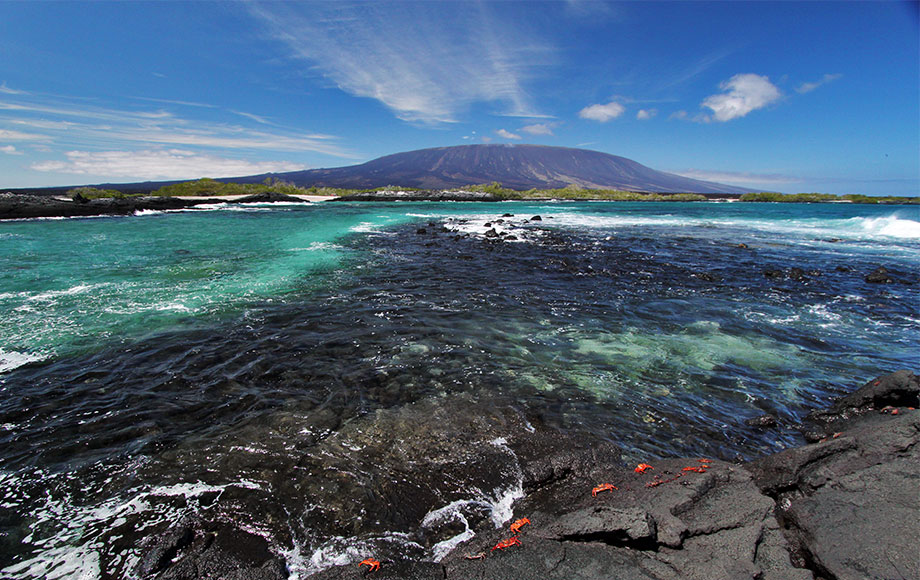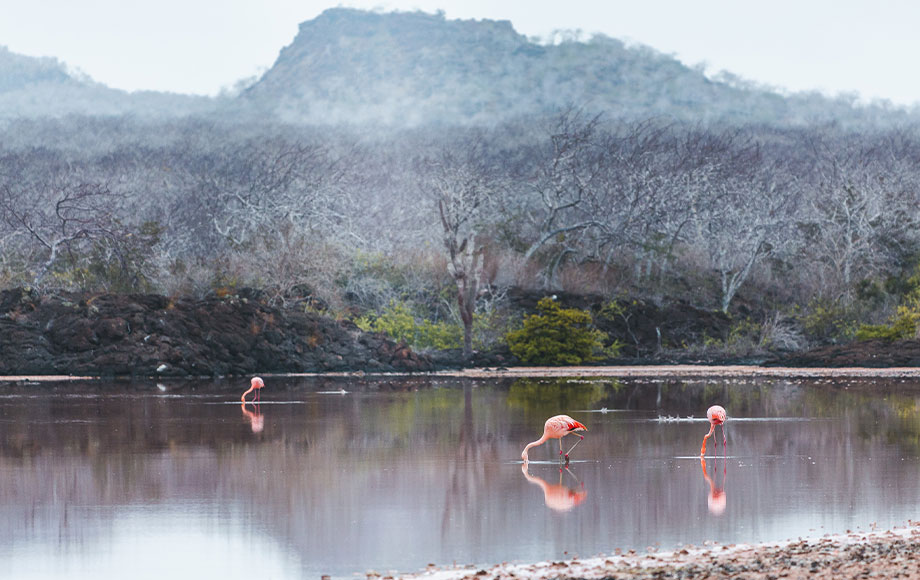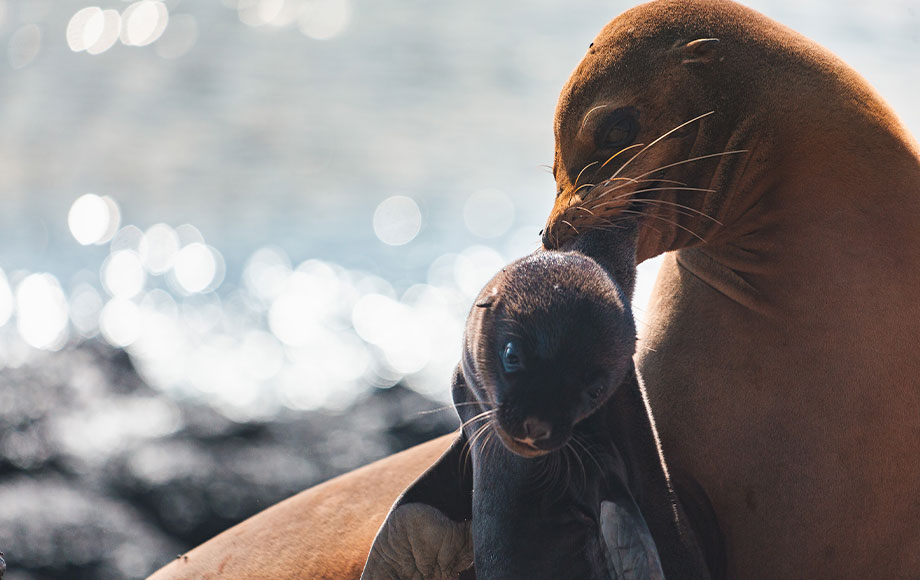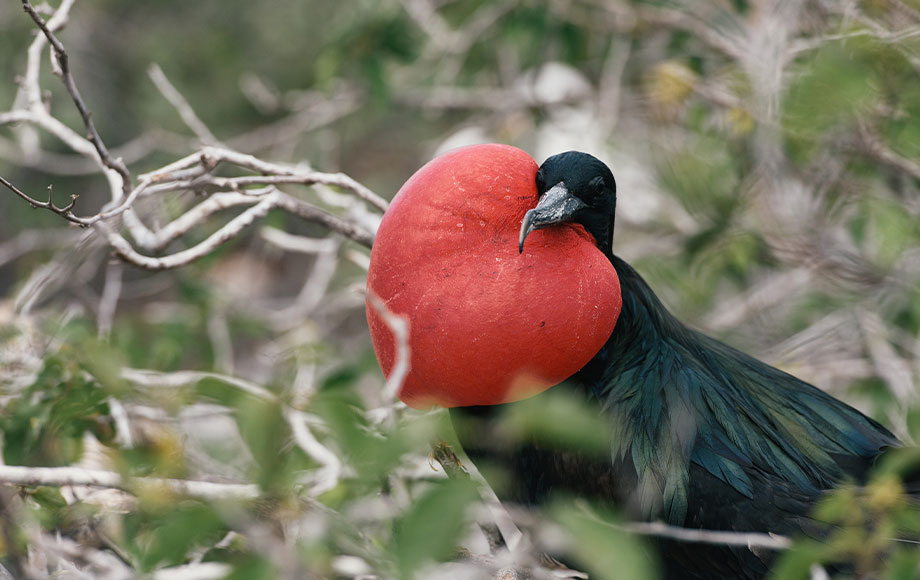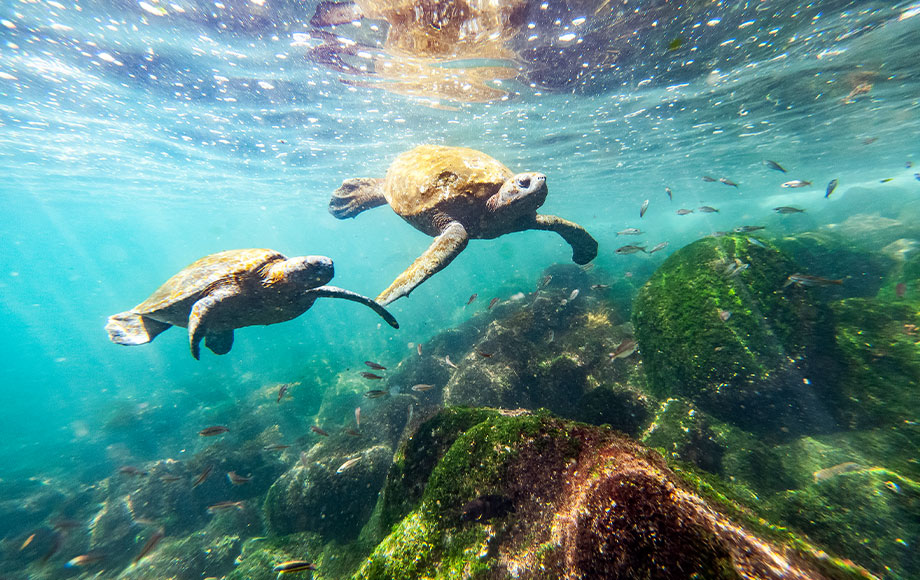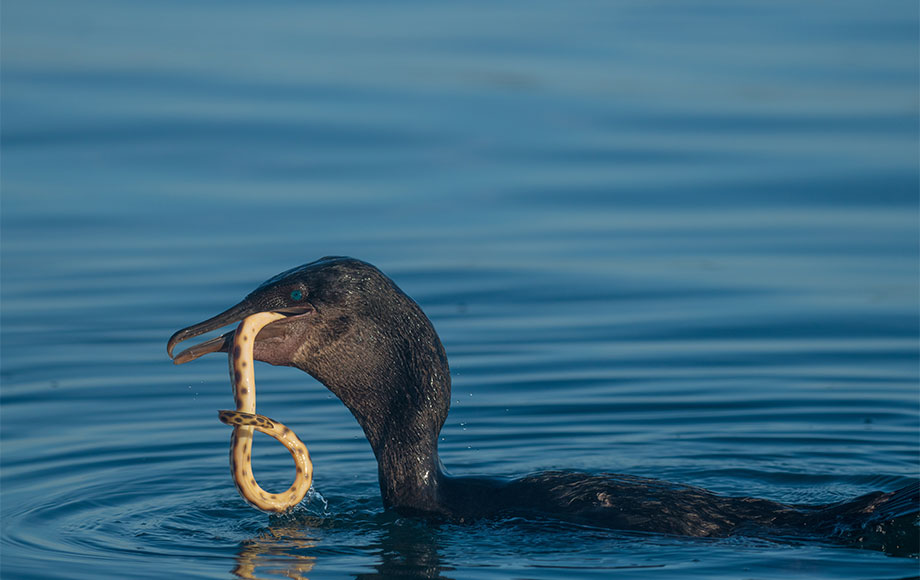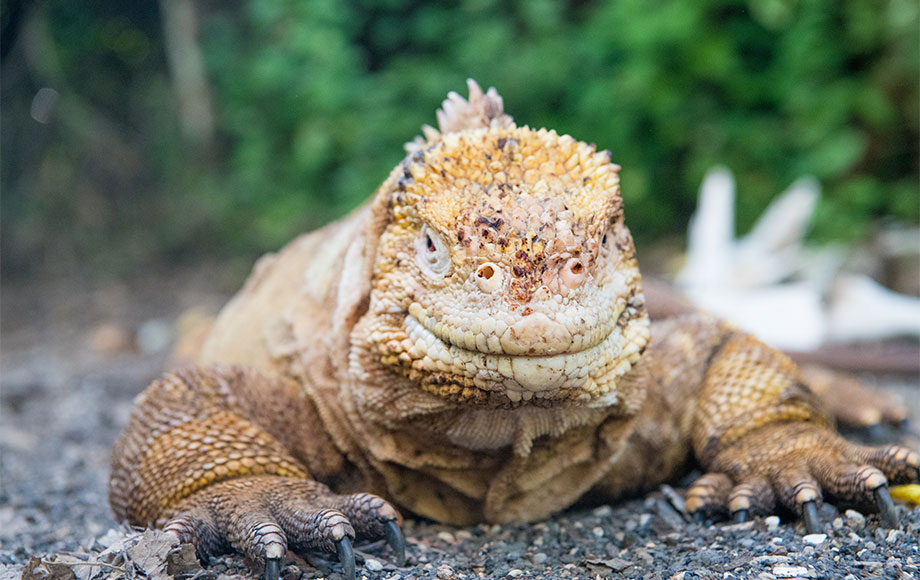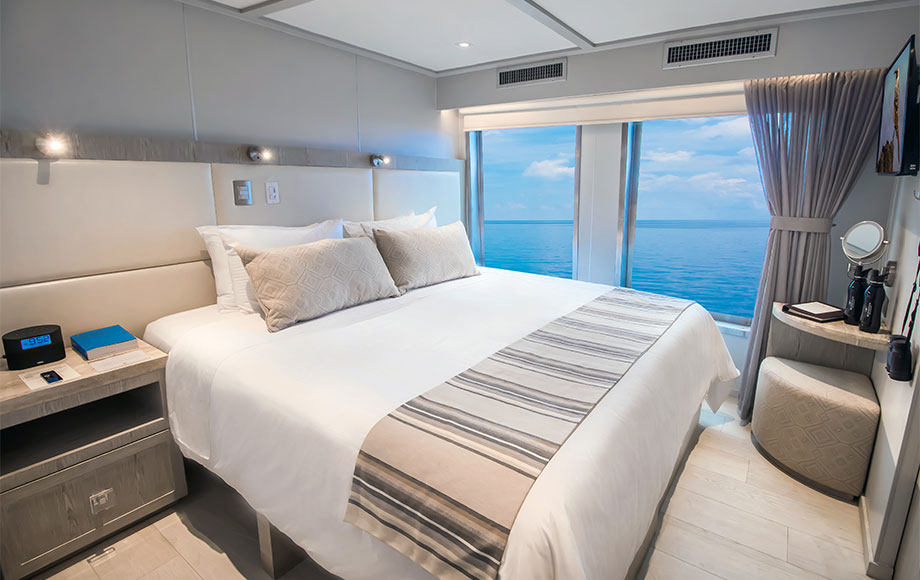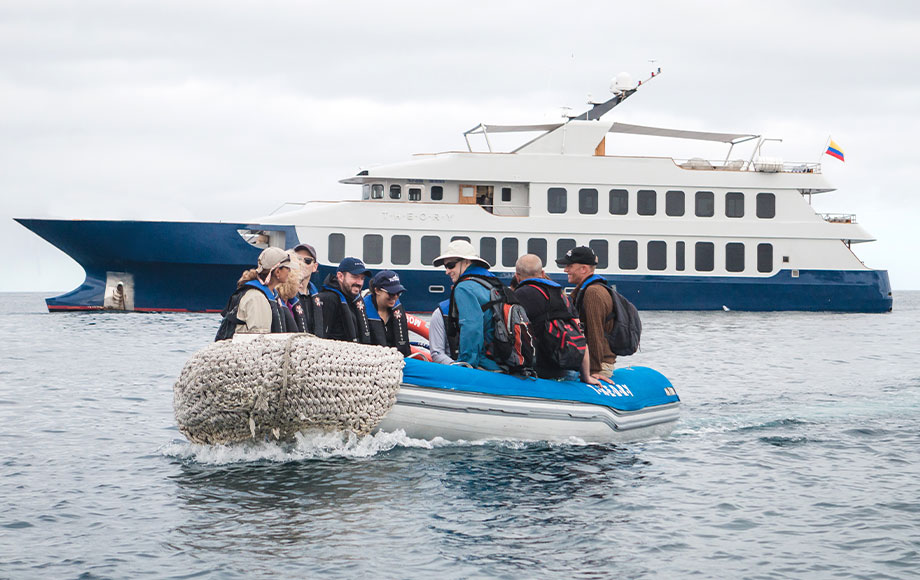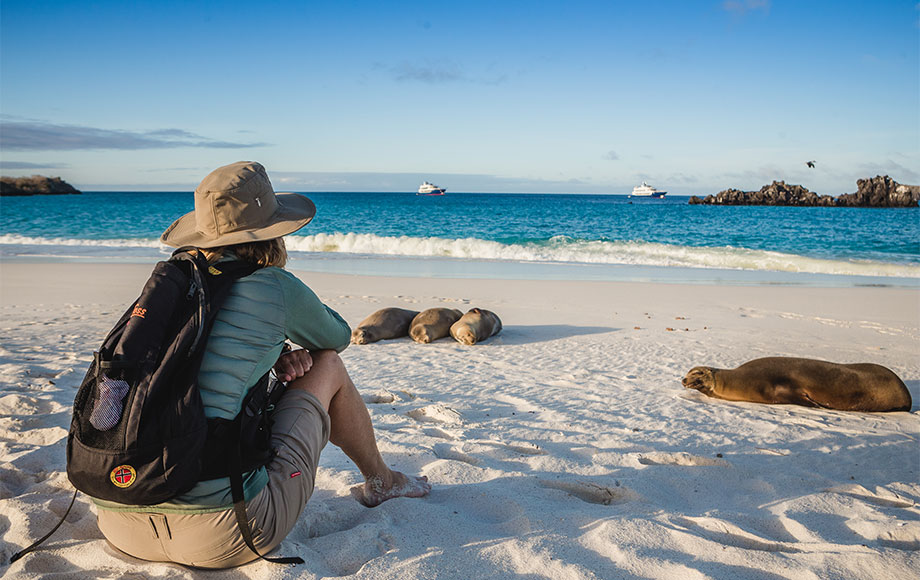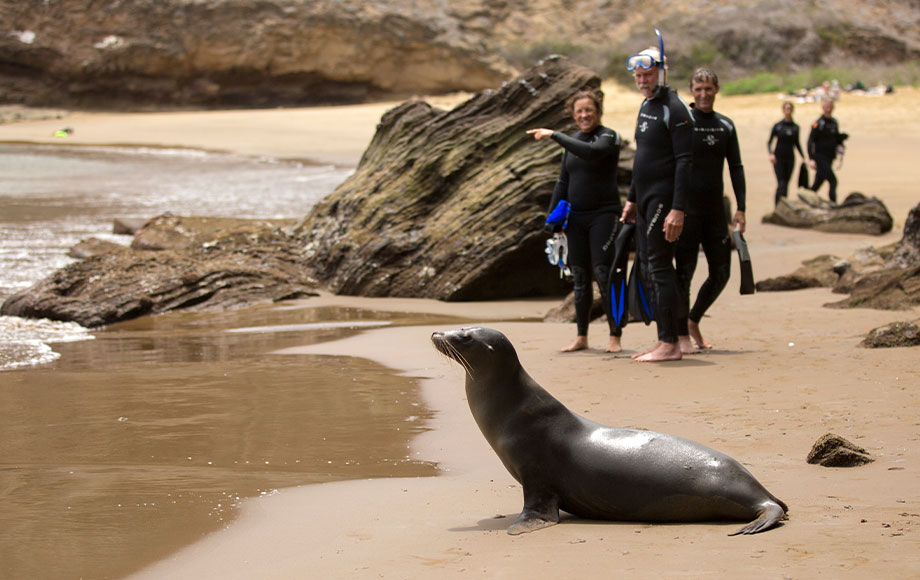Galapagos Extravaganza
15 Days / 14 nights
Departs Sundays ex San Cristobal
Southern/Central
Tour Cost
Prices on request
"*" indicates required fields
This 15 day/14 night itinerary combines the very best of the southern, north and central islands.
Discover the unique diversity of the Galapagos Island’s on this epic 14-night luxury cruise exploring Floreana, Espanola, San Cristobal, Santa Cruz, South Plaza and North Seymour islands.
This itinerary combines the very best the Galapagos has to offer from its pristine beaches, incredible wildlife and awe-inspiring scenery. Spend your days cruising from island to island in complete luxury, anchoring in quiet inlets and exploring crowded beaches filled with birds, sea lions and iguanas.
A geological wonder hidden 1,000 kilometres off the coast of Ecuador, the Galapagos Islands have been a fascination for scientists and travellers since Charles Darwin first visited the islands in 1835. The fascinating evolutionary changes that have taken place amongst the wildlife over millennia helped Darwin form his theory of evolution.
Birdlife and wildlife have become so used to humans that you can get within a few feet of some species. Search for renowned species such as the marine iguana, giant tortoise and Galapagos penguin. Iconic bird species to search for include blue footed and Nazca boobies, frigate birds, flamingos and Darwin’s finches – one of the key species that helped to formulate Darwin’s theory of evolution. When walking on the island’s you will always have to watch your step in case you stand on a sunbaking land or marine iguana. Spend your days on guided walking excursions, swimming or snorkelling the crystal-clear waters or exploring the coastline by kayak or motorised-dinghy.
Please note: To reduce the impact of tourism, the national park authorities control the itineraries for all Galapagos cruise operators.
Tour details
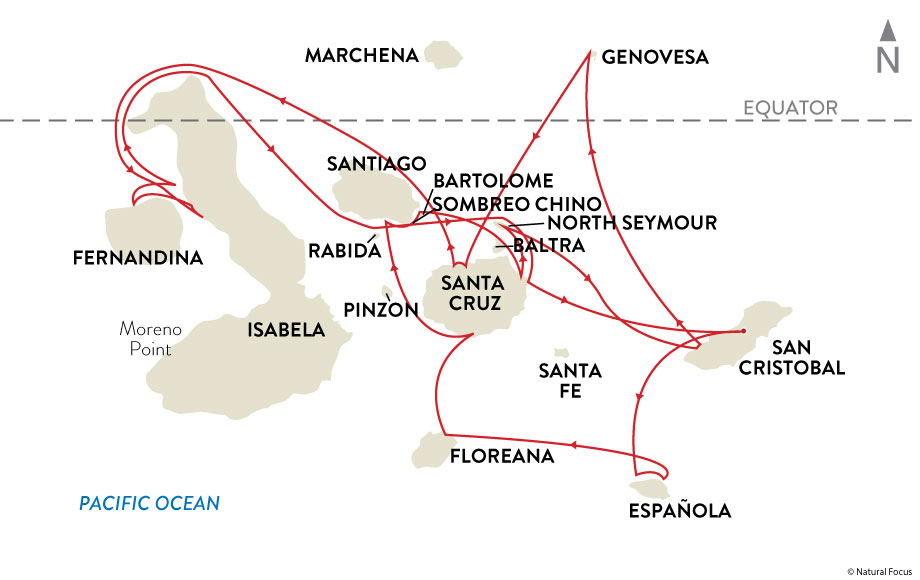
- Set foot on the island’s made famous by Charles Darwin
- Visit the Charles Darwin Research Station
- Discover the diverse birdlife including blue-footed booby’s, frigate birds and shearwaters
- View bachelor sea lions at South Plaza Island
- Swim and snorkel with sea lions and other marine species
- Be careful not to step on sunbaking iguanas or sea lions
- Stop at Prince Philip’s Steps on Genovesa Island – home to a wealth of birdlife
- Explore Punta Espinoza on Fernandina Island and get close to marine iguanas
- Marvel at the breathtaking scenery such as Pinnacle Rock
- Travel onboard the M/V Origin or M/V Theory – members of esteemed Relais & Châteaux collection.
There are daily flights (2 hours) from Ecuador’s capital Quito and the country’s largest city Guayaquil to Puerto Baquerizo Moreno on San Cristóbal Island. Both Quito and Guayaquil are serviced by a number of airlines directly including KLM Royal Dutch Airlines, American Airlines, Air France and United. Latam Airlines, the major airline in South America offers direct flights to a handful of major US and European cities.
Itinerary
Galapagos Extravaganza
15 Days / 14 nights
Please note: This itinerary is an example of what you may do and see. Changes to the itinerary may occur without prior notice due to readjustment of National Park policies, weather conditions, seasonal changes or safety reasons. These decisions are oriented in terms of passenger safety and in the interest of the islands’ conservation and protection.
San Cristobal
Upon arrival on San Cristobal Island you will met and transferred to the vessel by bus and zodiac. Settle into your cabin and enjoy a delicious welcome lunch before a brief safety drill and introductory talk where you will also select your snorkel equipment. Your very first excursion will be to El Junco Lake on San Cristobal. Spanish for “sedge” El Junco is the caldera of an extinct volcano, filled with freshwater. Keep an eye out for sea lions in the harbour as you head back to the yacht – they can often be seen lounging around on the boardwalks and other boats. When you return onboard the Captain and crew will be there to welcome you with a refreshing drink before a briefing on tomorrow’s activities. Get to know your fellow passengers this evening during am multi-course dinner.
Punta Pitt (San Cristobal) & Cerro Brujo
Today starts with a zodiac excursion to look for wildlife at Cerro Brujo – translating to “Wizard Hill”. There are a wide variety of birds that can be found here including brown pelicans, brown noddy terns and blue-footed boobies who dive-bomb the water as they fish. Sally lightfoot crabs that scurry over the rocks can also be spotted – the crabs are black when they’re young but extremely colourful once fully grown. There are also unusual geological formations to witness, including the Cathedral, jokingly called Darwin’s Pants. This morning you’ll also be able to take in the gorgeous coral sand beach at your own pace. Enjoy a peaceful walk, swim with sea lions, paddle board or even kayak – the choice is entirely yours. Your guides will teach you about the various species of fish you encounter as well.
Following an eventful morning, return to the yacht for a BBQ lunch served on the sun deck (weather permitting) before going ashore at Punta Pitt for a hike. The terrain involves a little bit of climbing, but the site is considered one of the best places for bird-watching – as it is the only place where you’ll see all three species of boobies: the blue-footed, the red-footed, and the Nazca booby. Other birds you may see include frigates, swallow-tailed gulls, storm petrels and brown pelicans. Stop for a snorkel excursion at Pitt Rock, where you may find sea lions and colourful fish such as King Angel and Surgeon fish. Transfer back to vessel for a briefing and dinner. If weather permits, stare up into the night sky for star gazing.
Punta Suarez & Gardner Bay (Espanola)
This morning you’ll land at Punta Suarez on Espanola Island. There are a large number of endemic species living here, such as the waved albatross. These gorgeous birds spend the first several years of their lives in the open ocean before return to land to mate. Take care not to step on the marine iguanas sunbathing on the dark rocks and watch out for colourful sally light-foot crabs. These iguanas are usually black but acquire bright red and green coloration during mating season from the algae they eat. The trail leads to a dramatic ocean blow hole. The island is home to Darwin’s Finches, Hood mockingbird, Galapagos Doves, red-billed tropicbirds, Galapagos Hawks, Nazca boobies and fascinating swallow-tailed gulls – the only nocturnal gull in the world. Return to the yacht for a BBQ lunch served on deck (weather permitting). You may also like to watch a cooking demonstration on how to make Ecuadorian ceviche.
In the afternoon there is the option to snorkel at Tortuga Rock and explore the caves covered with invertebrates before heading to Gardener Bay. The bay offers beautiful white-sand beach where colonies of sea lions dot the shoreline. You will have the option to snorkel from the beach, kayak or paddle-board, or simply walk along the beach, sunbathe or explore the area. Darwin Finches, Espanola mockingbird and Galapagos hawks are all possible sightings. Following a fabulous afternoon’s excursion, return to the yacht for a briefing and dinner.
Punta Cormorant, Post Office Bay, Baroness Point (Floreana)
Floreana Island’s Punta Cormorant olive-sand beach is alive with the sounds of sea lions, lava herons, yellow-crowned night herons and blue-footed boobies. The colouring of the beach is caused by a high concentration of iron and manganese from the basaltic lava. Inland there is a brackish lagoon home to Bahama ducks, common stilts, Galapagos flycatchers and bright pink flamingos, the guides will point out the rich variety of plant life, including morning glories, cut-leaf daisies and the different mangrove species. The trail continues on to a beach where sea turtles lay their eggs in the powdery sand dunes and sting rays swim in the shallow water. There will be an opportunity (not to be missed) to snorkel at Devil’s Crown or Champion Islet, a shallow sunken crater colonised by a brilliant array of colourful fish and coral, white-tipped sharks, sea turtles, spotted eagle rays and sea stars.
Return to the yacht for lunch. Enjoy a lecture on the human history of the Galapagos and hear the fascinating story of why this island is sometimes called the Island of Mysteries. This afternoon participate in a thrilling Galapagos tradition at Post Office Bay, the site where English whaling vessels erected a post barrel in the late 18th century. When you drop a postcard in the barrel, no postage is required. Search through the postcards left by previous visitors, until you see one addressed to a location near your home, you may choose to take it with you and deliver it in person. Similarly, your note will be delivered by future visitors. Postcards will be available on board. Take a Zodiac excursion at Baroness Point to look for sea turtles and rays. Return to the yacht for a briefing followed by dinner and a fun filled entertaining pirate themed party (participation is optional).
Highlands of Santa Cruz & Charles Darwin Research Station
This morning you will wake up to a very different view – a harbour full of boats. The harbour at Puerto Ayora on Santa Cruz Island is bustling with activity. The town has a population of just 24,000. Travel by bus to a higher altitude with beautiful geological formations including the lava tunnels at El Mirador and Los Gemelos (the twins), a pair of massive craters. The highlight of the morning is a visit to a privately-owned ranch where giant tortoises roam free. These slow-moving giants can weigh as much as 225 kilograms (500 pounds). Lunch is served back onboard the yacht.
This afternoon learn about the most famous visitor to the Galapagos – Charles Darwin – as well as current conservation efforts, when you visit the Fausto Llerena breeding centre and Charles Darwin Research Station. Visit the exhibit honouring Lonesome George, whose death marked the extinction of his species of tortoise from Pinta Island. There’s another story with a happier ending: Diego, a tortoise from the San Diego zoo. Diego brought his species back from the brink of extinction by fathering hundreds of offspring. There will also be a chance to enjoy some free time to explore the town as you head back to the main dock. If you’re looking for a souvenir, this is the perfect time. Along the way there will be cafes with coffee, ice cream and internet. You’ll have the option to stay on land for dinner with transfers provided by Zodiac. Otherwise, return to the yacht for the usual delicious multi-course dinner. Today’s daily briefing will be held in the afternoon to allow for extra time in the evening.
Sombrero Chino, Las Bachas or Black Turtle Cove Bartolome
This morning you’ll have two options: Today’s hike is a challenge, climbing about 400 wooden steps winding around Bartolome Island, ending in a gorgeous panoramic view of Pinnacle Rock. Stop along the way as your guide describes the remarkable geology of the landscape – mini lava cones and bombs formed by flowing magma from past volcanic eruptions. Alternatively, If you’d rather skip the hike, enjoy a Zodiac ride around the island and look for penguins. These adorable animals (the second smallest type of penguin) may be swimming, diving playfully or grooming themselves on rocks. Following your hike, the crystal clear water beckons you to wade in from the beach. You may see schools of tropical fish, white-tipped reef sharks and Galapagos Penguins. Return to the vessel for a BBQ lunch served on the sundeck (weather permitting).
The itinerary for the remainder of the afternoon will depend on your vessel; but all visitors will enjoy lovely views and some of the Galapagos’ renowned wildlife.
Origin – will go ashore at Sombrero Chino (Chinese Hat), a small island that owes its name to its shape. Sea lions await on the beach, and as you explore, you’ll see marine iguanas and oystercatchers. The trail takes you past remnants of the island’s geological history, with volcanic rubble and cracked lava formations.
Theory – Visit Playa las Bachas (Spanish for barges), on the northern side of Santa Cruz. There will be an opportunity for snorkelling after exploring interior lagoons with vivid flamingos. Guests on the Letty have a Zodiac excursion at Caleta Tortuga Negra (Black Turtle Cove) through a series of coves and inlets surrounded by mangroves.
This evening after dinner, enjoy an informative and entertaining lecture. The topic for this evening is on Charles Darwin and evolution or some of the social and environmental projects on the islands.
South Plaza Island & North Seymour Island
Today’s adventures will begin at South Plaza, a small islet with tall cliffs and a trail home to a variety of plants and animals. This island’s species of “Opuntia” or prickly pear cactus has been decimated by invasive species, so you’ll see young plants surrounded by nets to protect them. Keep an eye out for nests belonging to a variety of birds, such as swallow-tailed gulls, shearwaters, small ground finches, and red-billed tropicbirds. This geological uplift is also home to a colony of bachelor sea lions, with dominant bulls in various stages of recovery from battles over prime beach territory. You’ll also have an opportunity to see land iguanas up close, and learn about how they differ to marine iguanas.
Return to the vessel for lunch, at which time the Captain will sail to North Seymour Island, where a spectacular sight awaits – frigate birds with red sacs on their chests inflated, seeking mates. At the height of mating season, you’ll be surrounded by dozens, but no matter what time of year you visit, there will still be some individuals seeking mates. The Galapagos Islands are home to two different species of frigates, Great and Magnificent, and your guides will teach you to identify the difference. You will have a final opportunity to snorkel in deeper water. Look for sharks, sea lions, and starfish, along with a variety of tropical fish.
Before dinner, the captain and crew join you for a champagne toast to celebrate a wonderful week during the Captain’s farewell party. During the briefing, you’ll receive detailed instructions for disembarking the next morning. After dinner, there is a special presentation from your guides.
San Cristobal Island
This morning visit the interpretive centre on San Cristobal and learn more about the human history of the islands. Enjoy a bit of free time in town before transferring back to the vessel for lunch, where you will meet your fellow travellers who will be joining you for the next 7-nights of your cruise. After lunch your Galapagos adventure continues with an excursion to Cerro Colorado to visit the Jacinto Gordillo Breeding Center. Here you’ll learn about the giant tortoise breeding program established by the national park to ensure that these animals continue to thrive, despite the endangered status of some species. You’ll also have a chance to learn about their evolution and the threats they face, from invasive species to habitat loss. While here you might also see the San Cristobal mockingbird and the Calandrinia plant, both endemic to this island. Return to the vessel where you will be welcomed by the captain and crew. There will be a short briefing on tomorrow’s activities before an elegant multi-course dinner, prepared by the accomplished onboard chefs.
Genovesa Island
This morning your first excursion takes you to Prince Philip’s Steps on Genovesa Island. It is one of the most spectacular places in the Galapagos for bird watching because of its sheer diversity of species. Expert guides will point out the different species such as red-footed boobies nesting in palo santo trees, Nazca boobies nesting near the trail or storm petrels. If you’re lucky you may even see the elusive short-eared owl.
Return to the vessel for a BBQ lunch on the yacht’s sun deck and a demonstration on how to make Ecuadorian ceviche. You will also have the option to explore the cliffs up close, either by kayak, stand-up paddleboard or on a deep-water snorkelling excursion from the Zodiac. Later in the afternoon, land at Darwin Bay – a gorgeous coral sand beach. Both swallow-tailed gulls and lava gulls gather her near the tide pools. A forest of Optuntia cactus and mangroves provide shelter for Great frigate birds. Males looking to attract a mate inflate a red pouch on their chests. Finish off a superb afternoon by relaxing on the beach or swimming in the water – potentially with friendly, playful sea lions. Return to the yacht for a short briefing followed by a delicious dinner. If the night is clear, take some time to stargaze – your guides will help point out constellations.
Santa Cruz Island
Today begins with a visit to Las Bachas (Spanish for barges) on the northern side of Santa Cruz Island. An interior lagoon is home to dozens of bright pink flamingos and the long white sand beach is a beautiful place for a quiet stroll. Guides will point out endemic plant species and share their knowledge about the Galapagos Islands fascinating history. You’ll also have time to snorkel from the beach, home to colourful tropical fish, sea stars, sea turtles and maybe even sharks that can be seen along the ocean floor. Return to the yacht for lunch. Afterward, listen to an enriching lecture that is informative and entertaining – the topic is on marine currents, climate and the geology of the Islands.
In the afternoon step ashore on Cerro Dragon (Dragon Hill) and enjoy a magnificent panoramic view of the bay and island landscape. You may see flamingos in the brackish lagoon, along with a variety of plants such as the opuntia cactus and Muyuyo trees. As you walk the trail, look for Darwin’s finches, Galapagos flycatchers, yellow warblers, and Audubon shearwaters. Your guides will also pause to point out birds such as stilts, pintail ducks and sandpipers. Scan the path for yellow Land iguanas (endemic to the Galapagos) resting in the sun. After walking the trail, return to the yacht for a briefing and dinner.
Isabela Island
Enjoy a morning Zodiac ride at Punta Vicente Roca, navigating the wave-sculpted caves and bring you up close to the tuff walls covered in colourful Sally light-foot crabs. Don’t miss the opportunity to snorkel here, there are chances to see penguins diving playfully in the water or grooming themselves on rock formations. Look for sea turtles as they poke their heads above the water or follow them as they swim gracefully beneath the surface. Afterward, return to the vessel for lunch. Following lunch, relax on deck and enjoy the scenery as the yacht sails through the Bolivar Channel. You may be lucky and see whales riding the bow waves or dolphins jumping in graceful arcs.
This afternoon disembark at Urbina Bay on Isabela Island and see some surprising evidence of volcanic activity. Four files of coastal seabed were exposed due to a dramatic uplift during an eruption in 1954, and some of the remaining coral skeletons still stand several feet high. A diverse collection of animal species await on the island including Galapagos land iguanas, marine iguanas, Darwin’s finches, brown pelicans, flightless cormorants and the occasional giant Galapagos tortoise. After your visit, return to the vessel for your nightly briefing and dinner. After dessert, step outside and observe the pale glow of the Milky Way. Guests of all ages will enjoy this fun filled evening and maritime ritual – the crew dress as pirates and guest participation is optional.
Fernandina Island
This morning you’re in for another geological wonder – a visit to Punta Espinoza on Fernandina Island – the youngest and most pristine Island in the Galapagos, formed by active volcanoes that stretch around the coast. There are no introduced animals on the island. Sea lions occupy the beach with resident bulls carefully guarding their territory from potential threats such as sharks. The island is also home to the largest colony of marine iguanas in the archipelago that warm themselves along the rugged shoreline, blending in with the dark rocks. Out on the point, your guide will point out the nests of flightless cormorants, which stay close to shore since they have lost their ability to fly. Take the opportunity to snorkel here, this area is frequented by large sea turtles. Return to the yacht for lunch served on the sundeck and don’t forget to keep an eye out for passing whales.
Enjoy a presentation on Charles Darwin and his theory of evolution, before heading off for your afternoon excursion to Tagus Cove. This fascinating cove was a favourite stopping point for pirates and whalers for centuries, you will see sections of the rocky cliffs are covered in graffiti from as far back as the 1800s. Hike through the beautiful landscape and witness a saltwater lagoon, lava fields and volcanic formations. It is also possible to explore the shoreline of the secluded cove by kayak or paddleboard. There are many animals to see here including Galapagos penguins, boobies, pelicans and other seabirds. Return for dinner. Tonight, the vessel heads towards the geographic centre of the archipelago and cross the equator for the third and final time.
Rabida and Santiago islands
This morning explore the dark red beach of Rabida Island. This small island is considered the geographic centre of the archipelago because its volcanic rocks are the most diversified in the archipelago. Enjoy a short hike that leads you to a saltwater lagoon filled with greater flamingos. Along the way, look for marine iguanas, mockingbirds and yellow warblers and keep your eyes peeled for Darwin’s finches. There are 14 species of finches on the islands – observing them helped Darwin formulate the basis for his theory of evolution. You can also choose to snorkel this morning. You may be able to see sea lions or rays; there are several species of rays that live on the Galapagos, the most common are golden rays and spotted eagle rays.
The itinerary for the remainder of the afternoon will depend on your vessel; but all visitors will enjoy lovely views and some of the Galapagos’ renowned wildlife.
Theory – Guests visit Puerto Egas on Santiago Island, where you’ll stroll along the shoreline looking for octopus, starfish and other sea life caught in the tide pools. Birdlife is also excellent and there is a chance to see species including great blue herons, lava herons, American oystercatchers and yellow-crowned night herons. At low tide, catch a glimpse of marine iguanas as they feed on exposed green algae. During mating season, green and red algae give the usually black marine iguanas beautiful coloration. The walk ends at the grottos, deep pools of clear water where you can encounter Galapagos fur seals once on the verge of extinction. Before returning to the yacht, take the opportunity to snorkel from the beach.
Origin – Guests enjoy a Zodiac excursion at Caleta Tortuga Negra (Black Turtle Cove) through a series of peaceful coves and inlets surrounded by mangroves whose large roots rise out of the water. If travelling between September and febuary you may see pairs of mating sea turtles. Possibly sightings also include white-tipped reef sharks and golden cow-nosed rays.
Return to the vessel for the Captain’s Farewell cocktail with the crew. Afterward enjoy dinner and a special presentation by your guides.
Santa Cruz Island
This morning you will wake up to a very different view – a harbour full of boats anchored in Academy Bay. Disembark at Puerto Ayora on Santa Cruz Island. Bustling with activity, the town has a population of 24,000 residents. This morning you will visit the Fausto Llerena breeding centre and the Charles Darwin Research Station where you will learn about ongoing conservation efforts. The newest exhibit honours Lonesome George, the last surviving tortoise from Pinta Island. With his species now extinct, Lonesome George has become a worldwide icon, emphasising the importance of preserving and protecting endangered wildlife. There’s another story with a happier ending: Diego, a tortoise from the San Diego zoo. Diego brought his species back from the brink of extinction by fathering hundreds of offspring. Afterwards, you will also learn about the history of the settlers of this Island on a guided tour through the streets of Puerto Ayora. You will also get a chance to stroll through town to shop for handmade souvenirs, Ecuadorian chocolate ice cream or coffee grown in the Galapagos. Return to the yacht for lunch.
In the afternoon board a bus for a short ride to a lava tunnel – a hollow formation created when lava on the earth’s surface cools and hardens while molten lava continues to flow in the middle. Your next stop will be Los Gemelos (The Twins), a pair of large, deep craters with vibrant plant life at higher elevation. Lastly, visit a privately-owned hacienda, where giant tortoises roam freely in their natural habitat, feeding or resting in shallow pools. Some weigh in excess of 225 kilograms (500 pounds). You’ll have the option to stay on land for dinner with transfers provided by Zodiac. Your guides or concierge will happily recommend a restaurant. Otherwise, return to the yacht for the usual delicious dinner.
Tour ends, San Cristobal Island
For your last morning in the Galapagos, disembark after breakfast and travel by bus to Cerro Tijeretas (Frigatebird Hill). Here you will come across colonies of both species of frigate birds – Great and Magnificent – lava lizards, medium ground finches and San Cristobal mockingbird. As the perfect way to finish your trip, follow the trail to Punta Carola for a spectacular view. A short bus ride will get you to the airport with plenty of time for check in.
More Galapagos Itineraries
Galapagos Extravaganza
15 days/14 nightsThis 15 day/14 night itinerary combines the very best of the southern, north and central islands exploring Floreana, Espanola, San Cristobal, Santa Cruz, South Plaza and North Seymour islands.
Legendary Galapagos – Beaches & Bays
8 days/7 nightsThis 7-night itinerary combines the very best of the southern and central islands exploring Floreana, Espanola, San Cristobal, Santa Cruz, South Plaza and North Seymour islands.
Legendary Galapagos – Volcanic Wonders
8 days/7 nightsThis 7-night itinerary combines the best of the northern and central islands including Genovesa, Santa Cruz, Isabela, Rabida and Fernandina islands.
Find out more about our South America, Mexico and Central America tours.
SUBSCRIBE TO RECEIVE UPDATES
"*" indicates required fields
